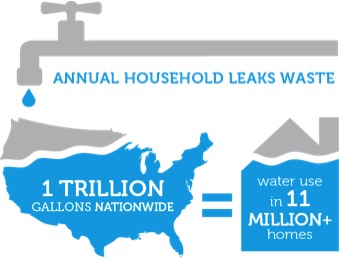This chart shows typical water use for residential customers, based on a study conducted by the American Water Works Association. You can reduce your indoor water use by changing how you use water and by replacing older washing machines, dishwashers, faucet aerators, shower heads and toilets with newer, more efficient appliances and plumbing fixtures.
Tips and Tools
For Every Room in the House with Plumbing
- Repair leaky faucets, indoors and out.
- Consider replacing old equipment (like toilets, dishwashers and laundry machines).
In the Kitchen
- When cooking, peel and clean vegetables in a large bowl of water instead of under running water.
- Fill your sink or basin when washing and rinsing dishes.
- Only run the dishwasher when it’s full.
- When buying a dishwasher, select one with a “light-wash” option.
- Only use the garbage disposal when necessary (composting is a great alternative).
- Install faucet aerators.
In the Bathroom
- Take short showers instead of baths.
- Turn off the water to brush teeth, shave and soap up in the shower.
- Fill the sink to shave.
- Repair leaky toilets. Add 12 drops of food coloring into the tank, and if color appears in the bowl one hour later, your toilet is leaking – frequently caused by a leaky flapper.
- Install faucet aerators and low-flow shower heads.
Laundry
- Run full loads of laundry.
- When purchasing a new washing machine, buy a water-saving model that can be adjusted to the load size.
Leaks
- Leaks account for a significant amount of water waste, both indoors and outdoors.
- Finding and fixing leaks will save both water and money. Don’t ignore dripping faucets, hose connections, toilet leaks – leaks add up to gallons of water in your home.

Follow the link to the epa.gov/watersense website for the source of this information.
Water Sense

Since the program’s inception in 2006, WaterSense has helped consumers save a cumulative 1.5 trillion gallons of water and more than $32.6 billion in water and energy bills. Visit the epa.gov/watersense website to find more information on the WaterSense label and partnership with manufacturers and national retailers like Home Depot and Lowe’s.
